Hand-held Stabilizers have come a long way over the years. From simple balanced mechanical stabilizers to advanced systems that rely on software to stabilize your awkward motions, the market has grown and you now have much more to choose from. But which one is right for you? If you care about good cinematography then chances are you are doing your research and landed here. We’ll be discussing one of our favorite companies out there for their simple, practical, and affordable stabilizer solutions. Glidecam has been around since 1991 and was developed by Martin Stevens who wanted to create a “common sense approach” to a more capable camera stabilizer for his own production needs. Through the years, Glidecam has produced a number of innovative solutions to help filmmakers around the world, capture stunning footage with professional quality on a prosumer budget. Glidecam offers a variety of hand-held stabilizers, among them are the XR series and the HD series. Each series has three different models: 1000 – geared for smaller camcorders, 2000 – geared for mid-sized cameras and DSLR’s, and 4000 – geared for full sized professional cameras. We will be taking a look at the XR 2000 and the HD 2000 to see how they compare to each other.
 Key Features
Key Features
- Dynamic Camera Balance Platform (Camera Mounting Platform)
- Adjustable convergence, precision, three-axis Gimbal
- No-tools Telescoping Center Post
- Adjustable, inertial-control Base Platform
- Foam padded Handle Grip
- Precision Bearings at all vital points
- Made with precision Aluminum
- Anodized Studio Black
- Laser etched Labeling
- Allows unrestricted Booming and 360 degree Panning
- Rubber feet under Base Platform
- Made in USA
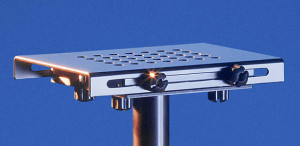 Glidecam’s XR series was actually re-designed to give you more versatility and ease of use. Made for use with a camera weighing anywhere from 2 to 6 pounds, this system is really easy to set up and go. Assembling this system for the first time took us about 10 minutes, which included trying to balance the camera. After spending more time with the XR 2000, we were able to set up and balance in under 5 minutes. For us, the hardest part was getting the balance just right. If you spend more time before production, setting up and balancing so it is just right, it makes filming so much easier and fluid. The XR 2000 has a more simple/bare-bones approach to balancing the head when compared to the HD 2000. There are no fine-tuning adjustment knobs on the XR 2000, but if you have some time and patience then you can get it balanced properly within a few minutes. The more you work with the XR 2000, the easier the setup and operation becomes.
Glidecam’s XR series was actually re-designed to give you more versatility and ease of use. Made for use with a camera weighing anywhere from 2 to 6 pounds, this system is really easy to set up and go. Assembling this system for the first time took us about 10 minutes, which included trying to balance the camera. After spending more time with the XR 2000, we were able to set up and balance in under 5 minutes. For us, the hardest part was getting the balance just right. If you spend more time before production, setting up and balancing so it is just right, it makes filming so much easier and fluid. The XR 2000 has a more simple/bare-bones approach to balancing the head when compared to the HD 2000. There are no fine-tuning adjustment knobs on the XR 2000, but if you have some time and patience then you can get it balanced properly within a few minutes. The more you work with the XR 2000, the easier the setup and operation becomes.
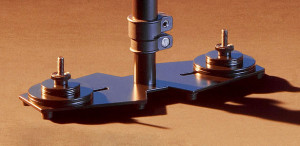 Balancing the XR 2000 is done in a similar fashion to the HD 2000. Both systems have to be balanced horizontally by finding the camera’s center of gravity, then mounting the plate marrying the two. Once that’s done, you’ll need to fine tune it’s horizontal axis by sliding the camera front, back, left, or right until the camera stays in position without any sway. After the horizontal balance has been achieved, you’ll need to balance the vertical axis by extending the base platform in or out, then by adding or subtracting the counter weight until you have about a three second drop during the “sled arc test”. This is done by holding the handle grip then positioning the base plate so that the whole unit is parallel to the ground. Once you let go of the base plate, it should take about three seconds till it retracts back to it’s original position. This is how you know you are ready to rock. Once you have a proper balance you’ll be able achieve incredibly smooth shots.
Balancing the XR 2000 is done in a similar fashion to the HD 2000. Both systems have to be balanced horizontally by finding the camera’s center of gravity, then mounting the plate marrying the two. Once that’s done, you’ll need to fine tune it’s horizontal axis by sliding the camera front, back, left, or right until the camera stays in position without any sway. After the horizontal balance has been achieved, you’ll need to balance the vertical axis by extending the base platform in or out, then by adding or subtracting the counter weight until you have about a three second drop during the “sled arc test”. This is done by holding the handle grip then positioning the base plate so that the whole unit is parallel to the ground. Once you let go of the base plate, it should take about three seconds till it retracts back to it’s original position. This is how you know you are ready to rock. Once you have a proper balance you’ll be able achieve incredibly smooth shots.
Obviously the more you work with any type of stabilizer, the more fluid and smoother your workflow and footage will be. Our take on it is, the goofier your walk looks while you are operating, the smoother your footage will look. Bend those knees and keep your torso as calm and relaxed as possible.
 Key Features
Key Features
- Fine adjustment Dynamic Camera Balance Platform (Camera Mounting Platform)
- Integrated quick-release Camera Plate
- Adjustable convergence, precision, three-axis Gimbal
- No-tools Telescoping Center Post
- Adjustable dynamic balance and inertial-control Base Platform
- Foam padded Handle Grip
- Precision Bearings at all vital points
- Made with precision Aluminum
- Anodized Studio Black
- Laser etched Labeling
- Allows unrestricted Booming and 360 degree Panning
- Rubber feet under Base Platform
- Made in USA.
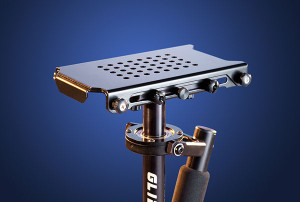 The HD 2000 is a few steps up from it’s predecessor XR 2000. Even though they both have a similar look, the HD 2000 has a few more features that make setup and production easier. Mainly, the camera-mounting platform with a quick-release plate. No tools are required for the plate and it also has two precision control knobs that help you really dial in a precise adjustment of the horizontal axis. The two knobs allow you to adjust the back and forth, and side-to-side movement. This feature right here saves a ton of time balancing and is much easier to use than the XR 2000.
The HD 2000 is a few steps up from it’s predecessor XR 2000. Even though they both have a similar look, the HD 2000 has a few more features that make setup and production easier. Mainly, the camera-mounting platform with a quick-release plate. No tools are required for the plate and it also has two precision control knobs that help you really dial in a precise adjustment of the horizontal axis. The two knobs allow you to adjust the back and forth, and side-to-side movement. This feature right here saves a ton of time balancing and is much easier to use than the XR 2000.
Aside from the mounting platform, the only other major difference is the base platform. The weights mount pretty much the same, but the actual base platform for the HD is a little longer. I actually prefer the shorter length on the XR 2000 as it doesn’t stick out as much and has less opportunity to get caught on your shirt or hit your belly or passing object/person.
XR 2000 Specs
- Designed for compact, low profile cameras weighing from 2 to 6 pounds.
- Camera Mounting Head Dimensions: 6.00″ x 4.187″ x .75″
- Base Platform Dimensions: 10.00″ x 4.00″
- Central Support Post: 1″ diameter
- 15″ tall in shortest mode
- 22″ tall in longest mode
- Weight: 2.1 pounds without Counter Weight Discs.
- Each large Counter Weight Disc averages 2.75 ounces.
- Each small Counter Weight Disc averages 1 ounce
- The Glidecam XR-2000 includes 12 large and 4 small Counter Weight Discs.
- 12 large Counter Weight Discs = 2.07 pounds
- 4 small Counter Weight Discs = .25 pounds
- Camera Mounting Plate has 1/4″ mounting holes.
- Base Platform has 1/4″ mounting hole for optional LCD Monitor attachment.
- Made in USA.
HD 2000 Specs
- Designed for compact, low profile cameras weighing from 2 to 6 pounds.
- X,Y Head Dimensions: 7.5″ x 4.125″ x 1”
- Base Platform Dimensions: shortest—11.5” x 4” Longest—15” x 4”
- Central Support Post: 1″ diameter
- 15″ tall in shortest mode
- 22″ tall in longest mode
- Weight: 2.53 pounds without Counter Weight Plates.
- Each Custom Counter Weight Plate averages .272 pounds.
- The Glidecam HD-2000 includes 12 custom Counter Weight Plates.
- 12 Counter Weight Plates = 3.264 pounds
- Camera Mounting Plate has 1/4″ mounting holes
- Base Platform has 1/4″ mounting hole for optional LCD Monitor attachment.
- Made in USA.
Similarities
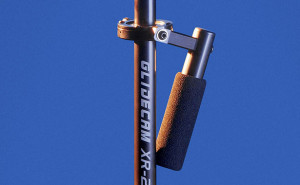 Both XR and HD series have an offset, foam cushioned handle grip that attaches to a free floating, three axis Gimbal. If you’ve used any type of stabilizer before then you’re probably aware of the up and down movement that happens when you are walking. This creates a pogo type of action that is hard to eliminate unless you have a proper handle like the one seen here in the XR and HD 2000.
Both XR and HD series have an offset, foam cushioned handle grip that attaches to a free floating, three axis Gimbal. If you’ve used any type of stabilizer before then you’re probably aware of the up and down movement that happens when you are walking. This creates a pogo type of action that is hard to eliminate unless you have a proper handle like the one seen here in the XR and HD 2000.
Differences
Looking at the specs you can see a few differences between the models. Aside from some minor differences like the weight and size, the biggest difference you’ll see is the fine adjustment dynamic camera balance platform with an integrated quick-release camera plate on the HD 2000. This is where the added investment might pay off if you have the extra cash. The ability to easily fine tune the camera so you get a perfect balance point is huge. Plus, if you’re on a shoot that requires little time in between takes (like every film shoot), then having an integrated quick-release camera plate is another added bonus.
 Final Thoughts
Final Thoughts
A price difference of $260 between the XR and HD is pretty significant if you are on a budget. If you’d rather save that extra cash and put it towards other gear then we think the XR 2000 will definitely get the job done. However, if you do have the extra spending money and want to be able to re-balance a little quicker when swapping out lenses or cameras, then the HD 2000 is the way to go. Either way, they are both a great buy and a good investment for your inventory.
Unlike other systems on the market today that require a longer setup time, battery power, software, bigger price tag, and sometimes two operators, the Glidecam XR and HD series is a much simpler, cost efficient, and versatile solution for those of you wanting to take your filmmaking skills to the next level (and not break the bank).
Best part about Glidecam gear is that when you are ready to upgrade, they make it easy. If you want to take your Hand-held stabilizer to the next level, they offer a body-mounted stabilizer that works with the hand-held stabilizer for an even better filming experience.
XR 2000 – $289 | HD 2000 – $549 or to learn more, check out Glidecam.com

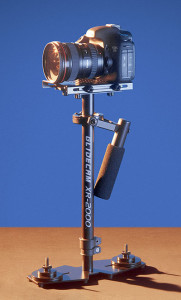
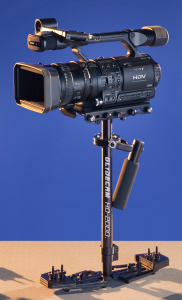
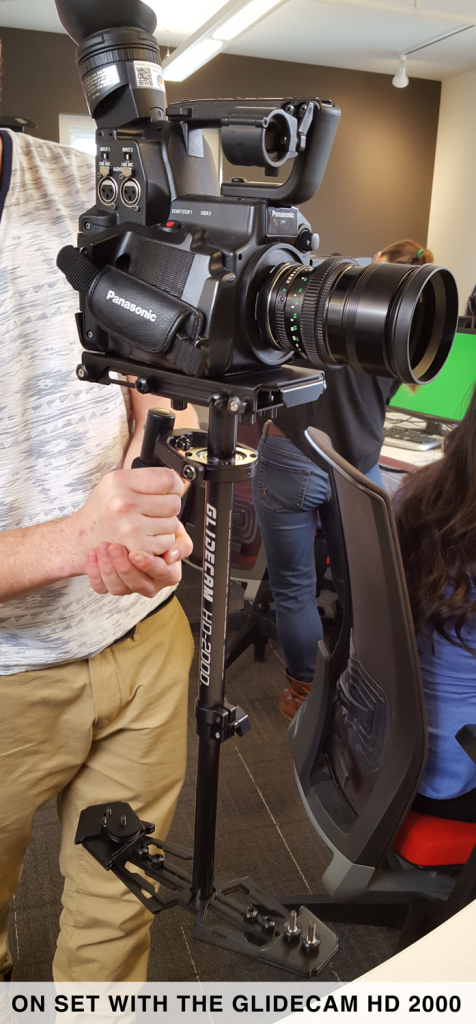
Leave a Reply